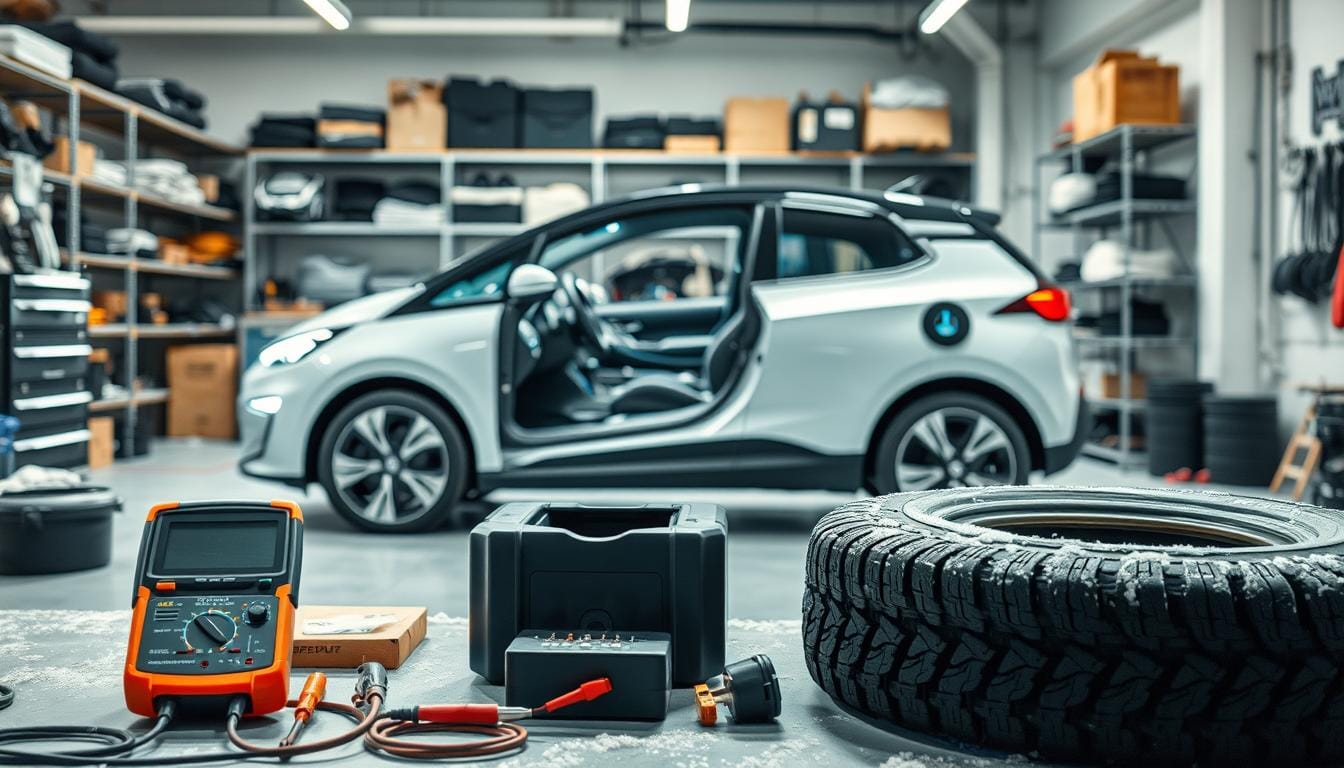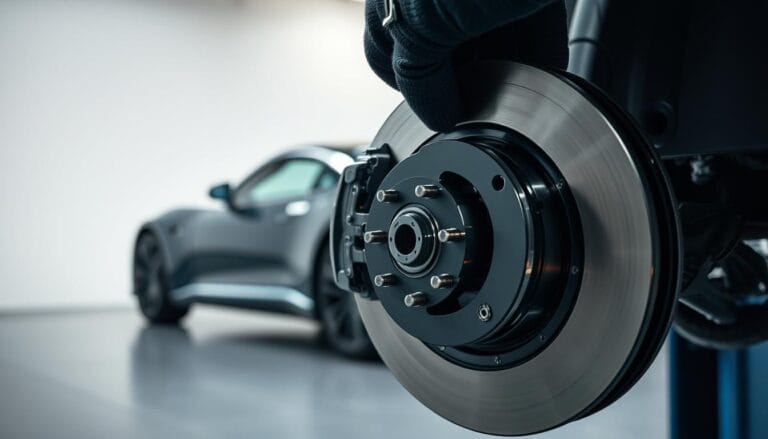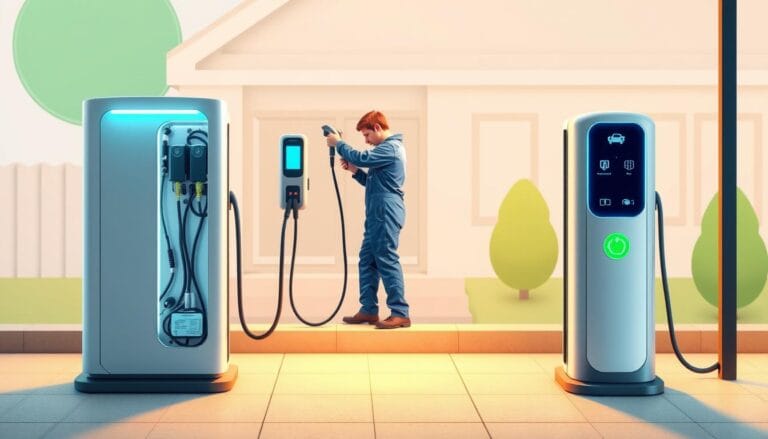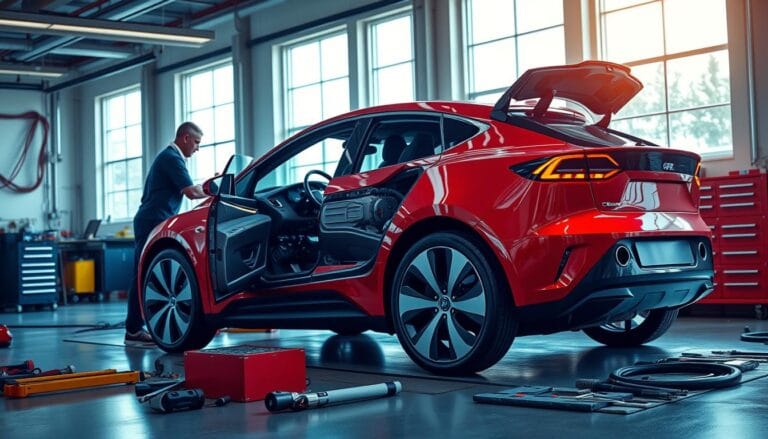Winter EV Maintenance: Keep Your Car Ready for Cold
As the first snowflakes start falling, electric vehicle owners face a big challenge. They must protect their cars from winter’s harsh weather. Winter EV maintenance is more than just keeping your car running. It’s about making sure it works its best during the coldest months.
Electric vehicles need special care when it gets cold. Cold weather can really affect your EV’s battery range and how well it charges. It’s important to winterize your electric car to keep it in good shape and make sure you feel confident while driving.
Knowing how winter affects your electric vehicle is key to being ready. Taking steps like managing your battery and checking your tires can greatly improve your winter driving. Every action you take can make a big difference.
Table of Contents
Importance of Winter Maintenance for Electric Vehicles
Winter brings special challenges for electric car owners. Cold weather can really affect how well your EV works and its battery life. It’s key to know these issues to keep your car running well when it’s cold.
Electric cars change a lot in cold weather. Even at 40° F, your EV’s range starts to go down. At 16° F, driving at 70 mph can cut your range by about 25%.
Why EVs Need Special Winter Care
Looking after your EV’s battery in the cold is very important. Lithium-ion batteries don’t like cold weather. This can cause:
- Less driving range
- Slower chemical reactions
- More internal battery resistance
- Longer charging times
Understanding Battery Performance in Cold Weather
To get the most out of your EV in winter, you need to prepare. Taking short trips in the cold and stopping a lot can use up to 50% of your range.
| EV Model | Winter Efficiency (mi/kWh) | Remaining Range (miles) |
|---|---|---|
| Kia EV9 Wind AWD | 2.0/2.1 | 116/110 |
| Tesla Model 3 Long Range AWD | 2.7/2.9 | 156/166 |
| Nissan Ariya Platinum+ AWD | 2.7/2.9 | 90/100 |
By being proactive and knowing how your EV performs in winter, you can keep your range and efficiency up.
Preparing Your EV for Colder Temperatures
Winter is tough for electric car owners. To keep your EV running well in the cold, you need to plan ahead and take care of it.
It’s key to shield your EV from the cold. Cold weather can hurt your car’s battery and how it drives.
Essential Pre-Winter Preparation Steps
- Park your EV in a garage or use a car cover when possible
- Check tire pressure monthly during cold climate EV charging seasons
- Utilize preconditioning features to warm battery and cabin
- Maintain battery charge above 50% during winter months
Battery and Charging Considerations
At very low temperatures, EVs can lose up to 50% of their range. To stay efficient:
- Charge your car just before you leave
- Use level 2 home chargers for faster charging in winter
- Plan for more stops to charge during winter trips
*Pro Tip: Modern EVs have advanced battery management systems designed to operate efficiently in lower temperatures.*
Cold Climate EV Charging Strategy
Build a strong charging plan. Find public charging spots on your usual routes. Also, think about getting a home charger for easy winter charging.
Don’t forget to pack a winter emergency kit. It should have:
- Blankets
- Portable tire patch kit
- Ice scraper
- First-aid supplies
- Portable water and snacks
With these tips, your EV will perform better, stay safe, and be reliable even in the coldest months.
Battery Care and Management in Winter
Winter brings special challenges for electric vehicle batteries. Cold weather can greatly affect your EV’s range and charging. It’s key to take care of your EV’s battery in cold weather to keep its range up.
It’s important to know how cold affects your EV’s battery. In very cold temperatures, EVs can lose up to 40% of their range. This can be a big problem for drivers.
Cold Weather Battery Performance Impact
The cold weather has a big impact on battery efficiency. Here are some key points about EV battery performance in the cold:
- Range drops by 25-50% in cold conditions
- Charging times can increase by 50%
- Battery efficiency reduces below 68°F
- Internal battery resistance increases dramatically
Best Practices for Winter Battery Management
Here are some tips to protect your EV battery in the cold:
- Maintain battery charge between 20-80%
- Precondition battery before driving
- Store vehicle in a heated or insulated garage
- Use scheduled charging close to departure time
| Temperature Range | Battery Performance Impact | Recommended Action |
|---|---|---|
| Below 20°F | 40% Range Reduction | Precondition battery, minimize fast charging |
| 20-40°F | 25% Range Reduction | Use scheduled charging, keep battery warm |
| Above 40°F | Minimal Performance Impact | Normal charging and driving practices |
By following these tips, you can keep your EV running well in the winter. This also helps protect your battery for the long term.
Tire Maintenance for Your EV in Winter
Winter driving needs extra care for your electric vehicle’s tires. EVs have unique traits like instant torque and heavy weight. This makes tire upkeep key for safety and performance. Electric vehicles need special attention when facing snow and ice.
EVs wear out tires faster because of their weight and quick acceleration. Knowing how to care for your EV in winter can protect your investment. It also ensures your vehicle runs well.
Selecting the Right Winter Tires
Finding the right winter tires for your EV requires careful thought:
- Look for the Three-Peak Mountain Snowflake (3PMSF) symbol
- Choose tires made for cold weather
- Find tires with specific EV load ratings
- Opt for tires that balance range and grip
The Michelin X Ice Snow tire is great for EVs in winter. It offers better braking and lasts longer in tough weather.
Tire Pressure Management in Cold Weather
Winter weather affects tire pressure a lot. Important tips for EVs in winter include:
- Check tire pressure every month
- Fill tires to the recommended PSI
- Use your vehicle’s Tire Pressure Monitoring System (TPMS)
- Know that tires lose about 1 psi each month
Good tire care boosts snow and ice grip for EVs. It also improves safety and keeps battery range up during winter.
Checking Fluid Levels and Wiper Blades
Winter EV maintenance is all about keeping your car’s fluids and wiper blades in check. Electric vehicles have fewer fluids than gas cars, but what they have is vital for cold weather.
Even though electric cars need special care in winter, some maintenance tasks are the same. Making sure your EV’s fluids are right helps it run well all winter.
Essential Fluids to Monitor
Your electric vehicle has important fluids to watch during winter:
- Coolant: Keeps the battery at the right temperature
- Brake fluid: Needs a new one every 4-5 years
- Windshield washer fluid: Made for cold weather
For coolant, getting a pro to check it is best. EV battery cooling systems are complex. Most makers say to have a pro check the fluid levels and type.
Importance of Visibility in Winter Conditions
Winter driving needs clear vision. Your wiper blades are key to seeing well in bad weather.
- Change wiper blades every 15,000 miles
- Use winter wiper blades for better performance
- Use winter windshield washer fluid that won’t freeze
By focusing on these maintenance steps, your electric vehicle will stay safe and reliable all winter. Regular checks and care are essential for winter EV maintenance.
Maintaining Your EV’s Exterior and Interior
Winterizing electric cars means taking care of both the outside and inside. Cold weather makes it important to maintain your car well. This keeps it running smoothly during winter.
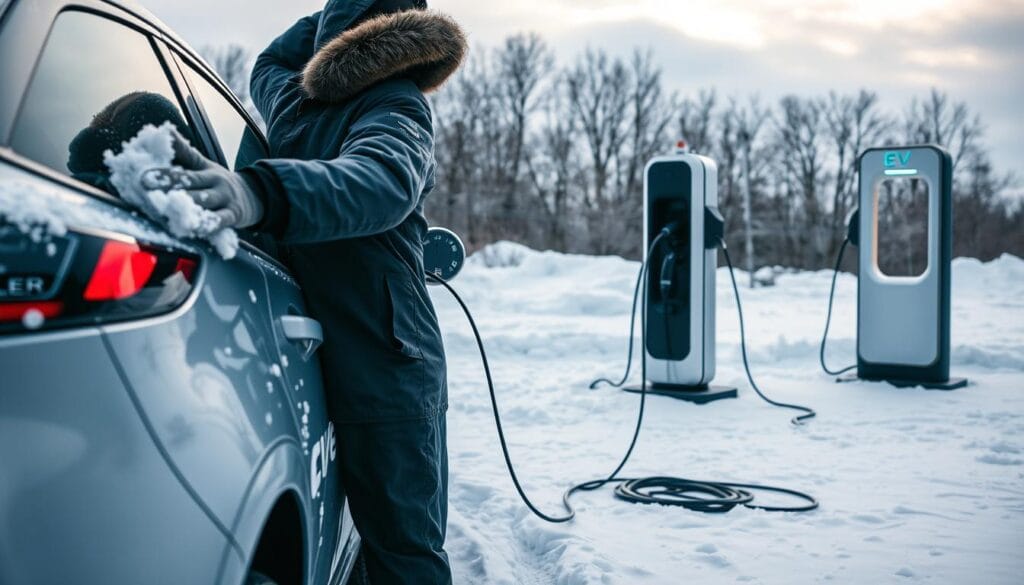
Protecting your car’s outside from salt and dirt is key. Road salt can harm your car’s underside and paint if not cleaned.
Exterior Protection Strategies
- Wash your EV regularly to remove corrosive road salt
- Apply a protective wax coating before winter
- Pay special attention to the undercarriage
- Inspect for possible rust or paint damage
Interior Comfort and Efficiency
To keep your EV’s cabin warm, manage energy wisely. Use smart heating methods that save battery life.
| Heating Method | Battery Impact | Efficiency |
|---|---|---|
| Seat Heaters | Low | High |
| Cabin Heat | High | Low |
| Pre-conditioning | Minimal | Very High |
Pro tip: Pre-condition your EV while it’s plugged in to maximize range and comfort. This method warms the interior without using battery power during your drive.
Moisture Management
Keep your interior dry to avoid electrical problems. Use floor mats, remove wet items, and ensure good air flow. This helps keep your EV’s interior in good shape during winter.
Emergency Preparedness for EV Owners
Driving an electric vehicle in winter needs careful planning. Unexpected problems can happen fast. That’s why an emergency kit is key for safe winter travel.
Electric car owners face special challenges in cold weather. The battery can lose up to 37% power at freezing temps. So, being ready for emergencies is vital.
Essential Winter Emergency Kit Items
Your emergency kit should have special items for electric cars:
- Portable EV charger or emergency charging cable
- Thermal blankets for temperature regulation
- High-visibility clothing
- Tire patch kit specific for EV tires
- First-aid kit
- Bottled water and non-perishable snacks
- Flashlight with extra batteries
- Compact ice scraper
Handling Battery Drain in Cold Temperatures
Keeping your battery in good shape is key in winter. Experts say keep your battery charge above 20% for emergencies.
Here are ways to reduce battery drain:
- Precondition your vehicle while plugged in
- Use heated seats instead of full cabin heating
- Plan routes with charging stations
- Drive at moderate speeds
- Park in a garage when possible
By following these tips, you can stay ready and confident in cold weather.
Utilizing Smart Features for Winter Driving
Driving an electric vehicle in winter needs smart feature use. These features help keep your EV’s range high and performance top-notch. Modern electric cars have advanced tech for cold weather driving.
Knowing how to use your EV’s smart systems can make winter driving better. Cold weather can cut your driving range by up to 41%. So, using smart features wisely is key for efficient winter travel.
Mastering Regenerative Braking in Winter Conditions
Regenerative braking is vital for EV range in winter. Here are tips to use it well:
- Adjust regenerative braking sensitivity based on road conditions
- Practice smooth deceleration to maximize energy recapture
- Learn to predict traffic flow to optimize energy recovery
Optimizing Heating Without Battery Drain
Preheating systems in EVs can greatly improve winter efficiency. Here are ways to save energy:
- Use heated seats and steering wheel instead of full cabin heating
- Preheat the vehicle while connected to charging station
- Utilize eco-mode to limit energy consumption
By using these smart strategies, you can keep your EV running well in winter. Preparation and smart use of your EV’s features are essential for a smooth winter drive.
Scheduling Regular Professional Maintenance
Winter EV maintenance is more than just DIY checks. Professional inspections are key to keeping your electric vehicle in top shape during cold weather. Most electric cars need special care every 18,000 miles or once a year, whichever comes first.
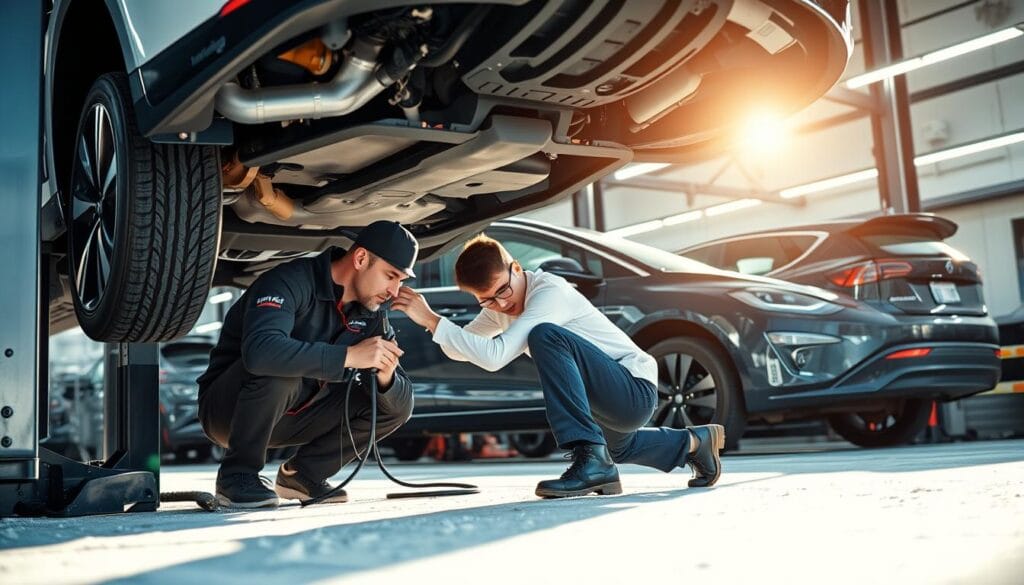
Cold weather battery care requires expert knowledge and the right tools. Electric vehicles have unique needs that are different from traditional cars.
Importance of Seasonal Check-Ups
Regular professional maintenance offers many benefits for EV owners:
- It helps keep the battery healthy and performing well.
- It finds problems early, saving you from expensive fixes later.
- It keeps your warranty valid.
- It ensures your car is safe to drive in winter.
What to Expect During a Winter Maintenance Inspection
A detailed EV winter maintenance inspection includes:
- Checking the 12-volt battery system.
- Looking at the thermal management system.
- Inspecting the brakes.
- Checking tire pressure and tread depth.
- Verifying the battery coolant level.
“Professional maintenance is not an expense, it’s an investment in your electric vehicle’s longevity and performance.”
Even though EV maintenance costs can be up to 43% less than for petrol cars, getting professional service is worth it. It keeps your car reliable in harsh winter weather.
Storing Your EV: Best Practices
Winterizing electric cars needs careful planning, mainly for long-term storage in cold months. The right storage keeps your electric vehicle’s battery healthy and its performance top-notch.
It’s key to care for your electric vehicle’s battery in cold weather, when it’s not in use for a while. The right storage plan stops unnecessary wear and keeps the battery safe from damage.
Long-Term Storage Recommendations
- Maintain battery charge between 50% and 80% during storage
- Avoid storing the vehicle with charge levels below 10% or above 80%
- Park in a heated or insulated garage when possible
- Use a breathable car cover to protect exterior from dust and moisture
Battery Preservation Techniques
Electric vehicles need special care during winter storage. Here are some important tips:
- Keep the vehicle plugged in to maintain battery temperature
- Use a battery tender for consistent charge maintenance
- Schedule periodic charging sessions for longer storage periods
- Disable battery-draining features like Sentry Mode
Winterizing electric cars is more than just looking after the battery. Clean your vehicle well before storage, apply a protective coating, and check all seals to keep moisture out.
Pro Tip: Storing your EV with around 70% charge helps maintain battery warmth and prevents possible degradation.
When you’re ready to use your electric vehicle again, do a thorough check and follow a careful charging routine. This ensures it runs at its best.
Resources and Tools for Winter EV Maintenance
Winter EV maintenance needs the right tools and support. Modern tech offers solutions for electric vehicles in cold weather. This ensures your car runs well and you stay worry-free.
Smart tech has changed winter EV care. It gives owners tools to face cold weather challenges.
Essential Apps for EV Owners
- BP Pulse App: Find public charging points quickly
- PlugShare: Locate charging stations nationwide
- EVgo: Real-time charging station availability
- ABRP (A Better Route Planner): Optimize winter driving routes
Technology to Assist in Maintenance
Digital tools help monitor your EV’s winter performance. Cold climate EV charging is easier with apps that track:
- Battery temperature
- Range in cold
- Charging schedules
- Energy use
Finding Local EV Service Centers
Finding the right service center is key for winter EV care. Look for certified technicians who know cold weather battery issues.
When searching, consider:
- Manufacturer-specific certifications
- Experience with electric vehicles
- Specialized winter maintenance services
- Advanced diagnostic equipment
Preparation is key for winter EV care. Use these digital tools and professional services. This keeps your EV reliable and efficient in cold.
Conclusion: Staying Ahead of Winter Challenges
As electric vehicle ownership grows, with 1.4 million EVs sold in the US in 2023, knowing how to maintain them in winter is key. Winter driving tips for electric vehicles are not just suggestions. They are vital to protect your investment and keep your car running well in cold weather.
Your winter EV maintenance should include taking care of the battery, managing tires, and planning ahead. Cold weather can cut your car’s range by up to 30%. By following the tips in this guide, you can keep your EV running at its best.
Preparation and knowledge are the keys to driving your electric vehicle well in winter. Park indoors, keep the battery charged above 20%, use winter tires, and know how your car handles cold. Early action and regular care are your best defense against winter problems.
With the right winter EV maintenance, driving in cold weather can be easy and even fun. Start using these tips now. You’ll be ready to keep your electric vehicle in top shape all winter long.

